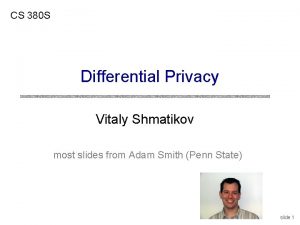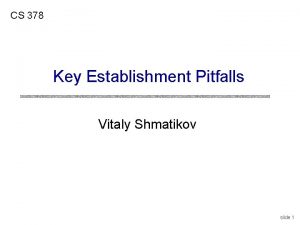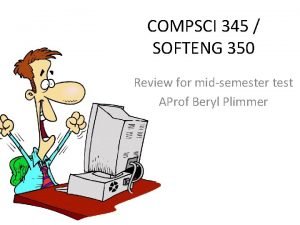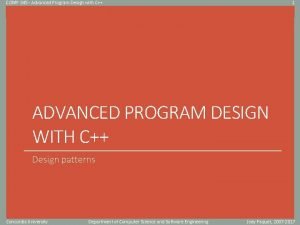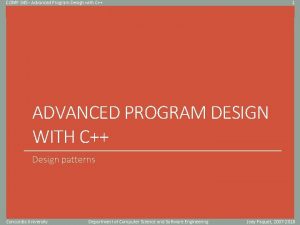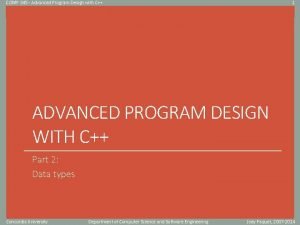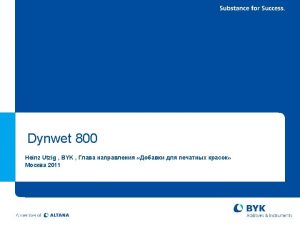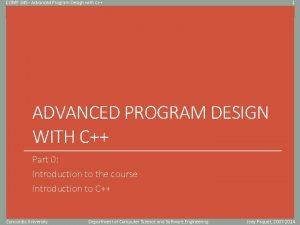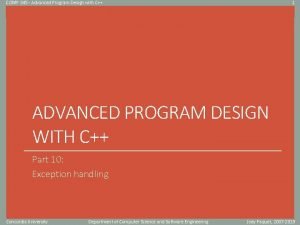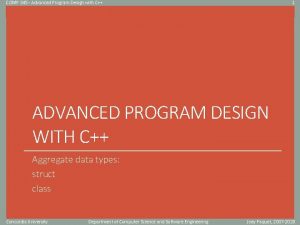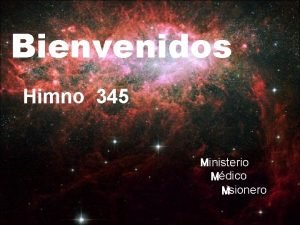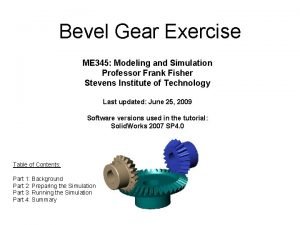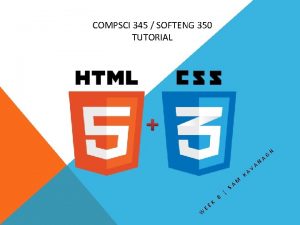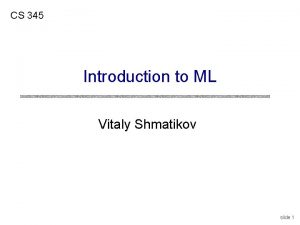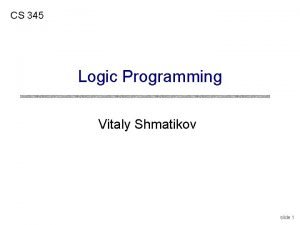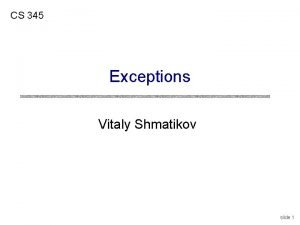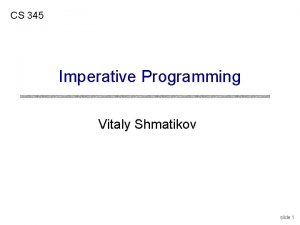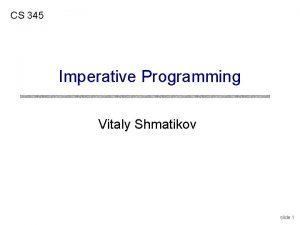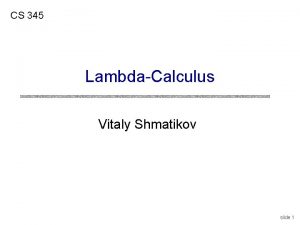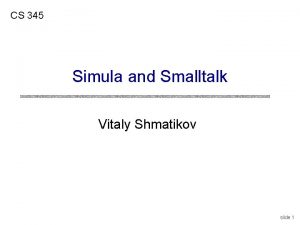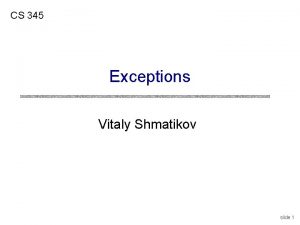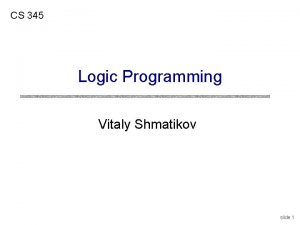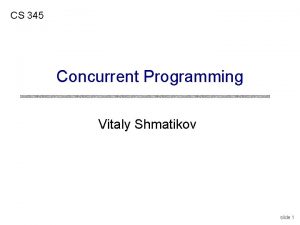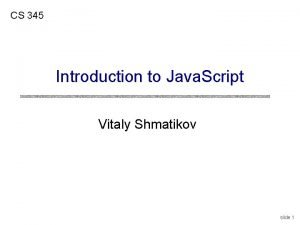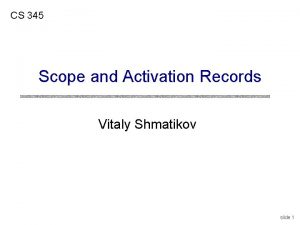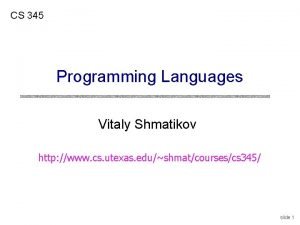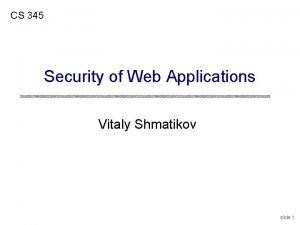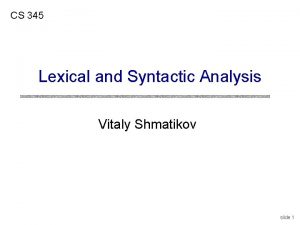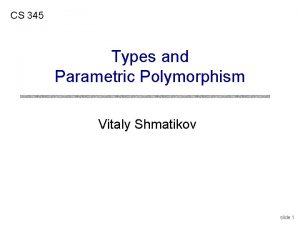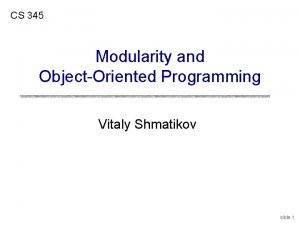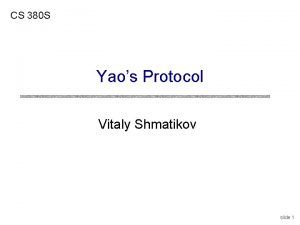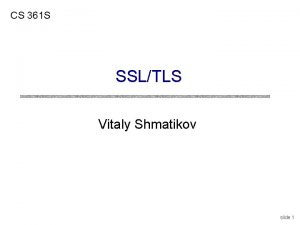CS 345 Introduction to Scheme Vitaly Shmatikov slide




















- Slides: 20

CS 345 Introduction to Scheme Vitaly Shmatikov slide 1

Reading Assignment u. Mitchell, Chapter 3 u“Why Functional Programming Matters” (linked from the course website) u. Take a look at Dybvig’s book (linked from the course website) slide 2

Scheme u. Impure functional language u. Dialect of Lisp • Key idea: symbolic programming using list expressions and recursive functions • Garbage-collected, heap-allocated (we’ll see why) u. Some ideas from Algol • Lexical scoping, block structure u. Some imperative features slide 3

Expressions and Lists u. Cambridge prefix notation: (f x 1 x 2 … xn) • (+ 2 2) • (+ (* 5 4) (- 6 2)) means 5*4 + (6 -2) u. List = series of expressions enclosed in parentheses • For example, (0 2 4 6 8) is a list of even numbers • The empty list is written () u. Lists represent both functions and data slide 4

Elementary Values u. Numbers • Integers, floats, rationals u. Symbols • Include special Boolean symbols #t and #f u. Characters u. Functions u. Strings • “Hello, world” u. Predicate names end with ? • (symbol? ‘(1 2 3)), (list? (1 2 3)), (string? “Yo!”) slide 5

Top-Level Bindings udefine establishes a mapping from a symbolic name to a value in the current scope • Think of a binding as a table: symbol value • (define size 2) ; size = 2 • (define sum (+ 1 2 3 4 5)) ; sum = (+ 1 2 3 4 5) u. Lambda expressions • Similar to “anonymous” functions in ML • Scheme: (define square (lambda (x) (* x x))) • ML: fun square = fn(x) x*x – What’s the difference? Is this even valid ML? Why? slide 6

Functions u( define ( name arguments ) function-body ) • (define (factorial n) (if (< n 1) 1 (* n (factorial (- n 1))))) • (define (square x) (* x x)) • (define (sumsquares x y) (+ (square x) (square y))) • (define abs (lambda (x) (if (< x 0) (- 0 x) x))) u. Arguments are passed by value • Eager evaluation: argument expressions are always evaluated, even if the function never uses them • Alternative: lazy evaluation (e. g. , in Haskell) slide 7

Expression Evaluation u. Read-eval-print loop u. Names are replaced by their current bindings • x ; evaluates to 5 u. Lists are evaluated as function calls • (+ (* x 4) (- 6 2)) ; evaluates to 24 u. Constants evaluate to themselves. • ‘red ; evaluates to ‘red u. Innermost expressions are evaluated first • (define (square x) (* x x)) • (square (+ 1 2)) (square 3) (* 3 3) 9 slide 8

Equality Predicates ueq? - do two values have the same internal representation? ueqv? - are two numbers or characters the same? uequal? - are two values structurally equivalent? u. Examples • • • (eq ‘a ‘a) #t (eq 1. 0) #f (system-specific) (eqv 1. 0) #t (eqv “abc”) #f (system-specific) (equal “abc”) #t (why? ) slide 9

Operations on Lists ucar, cdr, cons • • (define evens ‘(0 2 4 6 8)) (car evens) ; gives 0 (cdr evens) ; gives (2 4 6 8) (cons 1 (cdr evens)) ; gives (1 2 4 6 8) u. Other operations on lists • • (null? ‘()) (equal? 5 ‘(5)) (append ‘(1 3 5) evens) (cons ‘(1 3 5) evens) ; ; gives #t, or true #f, or false (1 3 5 0 2 4 6 8) ((1 3 5) 0 2 4 6 8) – Are the last two lists same or different? slide 10

Conditionals u. General form (cond (p 1 e 1) (p 2 e 2) … (p. N e. N)) • Evaluate pi in order; each pi evaluates to #t or #f • Value = value of ei for the first pi that evaluates to #t or e. N if p. N is “else” and all p 1 … p. N-1 evaluate to #f u. Simplified form • (if (< x 0) (- 0 x)) • (if (< x y) ; if-then-else u. Boolean predicates: (and (e 1) … (e. N)), (or (e 1) … (e. N)), (not e) slide 11

Other Control Flow Constructs u. Case selection • (case month ((sep apr jun nov) 30) ((feb) 28) (else 31) ) u. What about loops? • Iteration Tail recursion • Scheme implementations must implement tailrecursive functions as iteration slide 12

Delayed Evaluation u. Bind the expression to the name as a literal… • (define sum ‘(+ 1 2 3)) • sum (+ 1 2 3) – Evaluated as a symbol, not a function u. Evaluate as a function • (eval sum) 6 u. No distinction between code (i. e. , functions) and data – both are represented as lists! slide 13

Imperative Features u. Scheme allows imperative changes to values of variable bindings • (define x `(1 2 3)) • (set! x 5) u. Is it Ok for new value to be of a different type? Why? u. What happens to the old value? slide 14

Let Expressions u. Nested static scope u(let ((var 1 exp 1) … (var. N exp. N)) body) (define (subst y x alist) (if (null? alist) ‘() (let ((head (car alist)) (tail (cdr alist))) (if (equal? x head) (cons y (subst y x tail)) (cons head (subst y x tail))))) u. This is just syntactic sugar for a lambda application (why? ) slide 15

Let* u(let* ((var 1 exp 1) … (var. N exp. N)) body) • Bindings are applied sequentially, so vari is bound in expi+1 … exp. N u. This is also syntactic sugar for a (different) lambda application (why? ) • (lambda (var 1) ( (lambda (var 2) ( … ( (lambda (var. N) (body)) exp. N) … ) exp 1 slide 16

Functions as. F Arguments (define (mapcar fun alist) (if (null? alist) ‘() (cons (fun (car alist)) (mapcar fun (cdr alist))) )) (define (square x) (* x x)) What does (mapcar square ‘(2 3 5 7 9)) return? (4 9 25 49 81) slide 17

“Folding” a Data Structure u. Folding: processing a data structure in some order to construct a return value • Example of higher-order functions in action u. Summing up list elements (left-to-right) • (foldl + 0 ‘(1 2 3 4 5)) 15 – Evaluates as (+ 5 (+ 4 (+ 3 (+ 2 (+ 1 0)))). Why? • (define (sum lst) (foldl + 0 lst)) u. Multiplying list elements (right-to-left) • (define (mult lst) (foldr * 1 lst)) • (mult ‘(2 4 6)) (* (* (* 6 4) 2) 1)) 48 slide 18

Using Recursion u. Compute length of the list recursively • (define length (lambda(lst) (if (null? lst) 0 (+ 1 (length (cdr list)))))) u. Compute length of the list using foldl • (define length (lambda(lst) (foldl (lambda (_ n) (+ n 1)) 0 lst) ) Ignore 1 st argument. Why? ) slide 19

Key Features of Scheme u. Scoping: static u. Typing: dynamic (what does this mean? ) u. No distinction between code and data • Both functions and data are represented as lists • Lists are first-class objects – Can be created dynamically, passed as arguments to functions, returned as results of functions and expressions • This requires heap allocation (why? ) and garbage collection (why? ) • Self-evolving programs slide 20
 Vitaly shmatikov
Vitaly shmatikov Shmatikov
Shmatikov Heel toe polka music
Heel toe polka music Vitaly attack
Vitaly attack Vitaly feldman
Vitaly feldman 3 domain scheme and 5 kingdom scheme
3 domain scheme and 5 kingdom scheme Stata schemes
Stata schemes Ponzi scheme vs pyramid scheme
Ponzi scheme vs pyramid scheme Softeng 350
Softeng 350 Digital clock in c++ using class
Digital clock in c++ using class Comp 345
Comp 345 Comp 345 final
Comp 345 final Byk-346
Byk-346 Comp 345
Comp 345 Comp 345
Comp 345 Comp 345
Comp 345 Himno 345
Himno 345 Me 345
Me 345 345 king william street adelaide
345 king william street adelaide Softeng 350
Softeng 350 Hbpc-345
Hbpc-345

